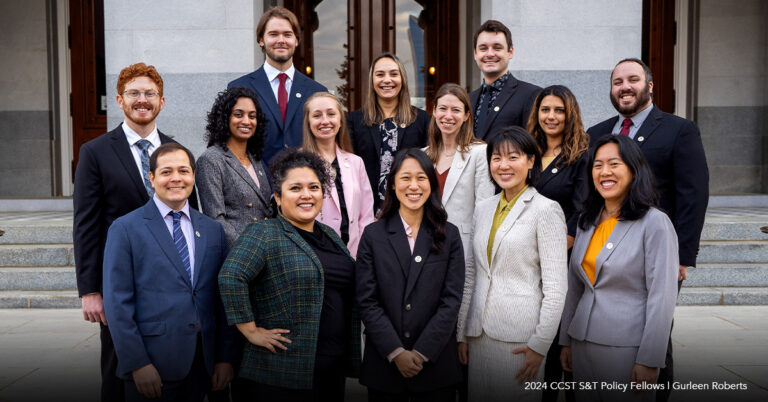Update: Applications for the CCST Science & Technology Policy Fellowship Have Closed
After Four Decades, Program Spearheaded by Caltech Proves Einstein Right and Makes History
February 22, 2016 | CCST Newsroom, Press Releases | Contact: M. Daniel Decillis

When Einstein announced his theory of relativity in 1915, he rewrote rules for space and time which had stood unchanged since the days of Sir Isaac Newton, transforming theoretical physics and astronomy. Over the decades which followed, one aspect of the theory remained unobserved: the existence of gravitational waves. That changed on September 14, 2015, when the Laser Interferometer Gravitational-Wave Observatory (LIGO) detectors observed ripples in the fabrication of spacetime for the first time ever, thanks to the determination and vision of scientists at Caltech (one of CCST’s sustaining institutions) and MIT.
The laser interferometer gravity-wave detector at the core of LIGO – which became the largest-ever project to be funded by the National Science Foundation – was first proposed by Rainer Weiss, a physicist at MIT. Weiss, however, wasn’t able to convince anyone to fund the project. But Kip Thorne, Richard P. Feynman Professor of Theoretical Physics at Caltech, refused to let the idea die.
“Without Kip Thorne, LIGO simply would not exist,” said David Reitze, executive director of the LIGO project, during a recent tribute to Thorne. “It’s a testament to his vision, passion, and drive. He had the ability to persuade the scientific community that this was not only possible, it was achievable.”
Thorne, who had co-authored a classic textbook on general relativity theory, became a proponent of efforts to fund LIGO as soon as he learned of the project Weiss had proposed. Although many thought that gravitational waves, if they existed, would likely be too small to detect, Thorne was able to convince colleagues at Caltech – a smaller institution known for its strong focus on fundamental research enquiries – that LIGO was feasible. In 1983, Thorne, Weiss, and another Caltech physicist (Ronald Drever) cofounded LIGO, and began the journey which led to the groundbreaking observations.

LIGO was used to detect the energy emitted from two merging black holes 1.3 billion light-years away. The strong burst of gravitational waves was released when a portion of the combined black holes’ mass was converted to energy, according to Einstein’s formula E=mc2. LIGO uses two detectors: one in Hanford, WA, and the other in Livingston, LA. LIGO detected the waves by measuring minute changes in distance between mirrors, using lasers.
“LIGO is the most precise measuring device ever built,” said Reitze. “It took us months of careful checking to make sure that what we saw was in fact a gravitational wave.”
The worldwide team of scientists involved with the LIGO project today – which includes more than 1,000 people – published a report on the discovery in Physical Review Letters on February 11. The article represents a triumph years in the making for the scientists at Caltech who got the project off the ground.
“Our observation of gravitational waves accomplishes an ambitious goal set out over five decades ago to directly detect this elusive phenomenon and better understand the universe,” said Reitze in a statement on Thursday.
M. Daniel DeCillis, PhD is the Spotlight editor and a Senior Research Associate at the California Council on Science and Technology.






